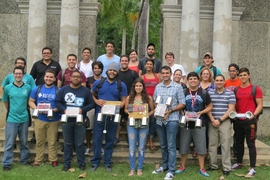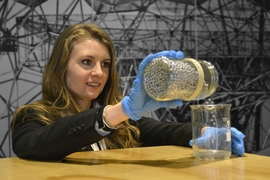MIT Lincoln Laboratory has been a world leader in interactive supercomputing since the 1950s. In 1955, TX-0, the first fully transistor-based computer, was built to support a wide range of research at the laboratory and the MIT campus, and became the basis for the second-largest computing company in the world, Digital Equipment Corporation. In 2001, the laboratory developed Parallel Matlab, which enabled thousands of researchers worldwide to use interactive supercomputing for high-performance data analysis. In 2008, the laboratory demonstrated the largest single problem ever run on a computer, using its TX-2500 supercomputer, a part of the system called LLGrid. In April, the laboratory acknowledged the importance of the LLGrid world-class computing capability with the establishment of the Lincoln Laboratory Supercomputing Center (LLSC).
LLSC is based, in part, on the LLGrid infrastructure, but was developed to enhance computing power and accessibility to more than 1,000 researchers across the Institute. "By establishing the LLSC, Lincoln Laboratory will be able to better address supercomputing needs across all Laboratory missions, develop new supercomputing capabilities and technologies, and spawn even closer collaborations with MIT campus supercomputing initiatives," says Jeremy Kepner, laboratory fellow, and head of the LLSC. "These brilliant engineers, scientists, faculty, and students use our capabilities to conduct research in diverse fields such as space observations, robotic vehicles, communications, cybersecurity, machine learning, sensor processing, electronic devices, bioinformatics, and air traffic control."
Only 13 years ago, the laboratory's supercomputing capability, LLGrid, was composed of a single 16-processor system. Albert Reuther, manager of LLSC, says that a "different kind of supercomputing" was clearly needed to meet the needs of laboratory researchers. Since then, the capability has expanded to thousands of processors across several systems. In addition, Reuther says that the center differs from others like it because of the team's "focus on interactive supercomputing for high-performance data analysis," and the “extremely 'green' computing center in Holyoke, Massachusetts, which allows our computers to run 93 percent carbon-free."
"This new level of supercomputing capability will be a key technology for the computational fluid dynamics (CFD) work performed in the Structural and Thermal-Fluids Engineering Group," says Nathan J. Falkiewicz. Falkiewicz explains that the new capability will allow his team to take advantage of the parallelism inherent in existing CFD codes to significantly reduce simulation time for computationally taxing problems, as well as enable simulation for certain classes of problems that would otherwise have "prohibitively long" execution times without access to large core-count, high-performance computing clusters.
Orion S. Crisafulli of the Active Optical Systems Group says that the supercomputing capability has enabled his team, in collaboration with MIT campus, to run complex simulations in the performance investigation of a compact microlidar system. "Access to a large number of compute nodes, each with substantial memory and a streamlined job submission process, has shortened the run time for our simulations from a week to a few hours," Crisafulli says. "This allows us to explore a significantly larger system parameter space than we would otherwise be able to, and ultimately achieve a more complete understanding of the capabilities of the microlidar system concept."
Reuther says that the LLSC exists today in large part because of the researchers who utilize supercomputing capabilities to produce cutting-edge research results, as well as many other supporters: "LLSC has been blessed to have the support of visionaries in the Director’s Office, the Technology Office, and the Steering Committee who have seen the potential of supercomputing to enable all of the Laboratory's missions." Reuther also credits the MIT Lincoln Laboratory Beaver Works Center for playing a critical role in the LLSC's collaborations with campus.
"Creating the Lincoln Laboratory Supercomputing Center has been a goal for the team for many years, and it is tremendously rewarding to see it come to fruition," Kepner says. "Laboratory researchers will see continued improvement in the LLSC systems, MIT Campus will benefit from our unique interactive supercomputing technologies, and Laboratory and campus researchers will be able to collaborate more closely on their joint research projects."










